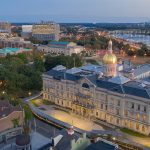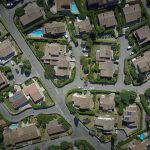New Jersey Future Blog
Heat, Air Quality, and Hope: Community Research and Resilience in Elizabeth, NJ
July 17th, 2024 by Sabrina Rodriguez-Vicenty

Famartin, CC BY-SA 4.0, via Wikimedia Commons
Elizabeth is nestled on the shore of Newark Bay in Union County, a dense, urban enclave in the heart of the Meadowlands estuary and wetlands. Our neighbors include: the Newark Liberty International Airport, where planes fly by my apartment multiple times a day creating noise nuisance. The Port Newark–Elizabeth Marine Terminal, the third-busiest container port in North America, and principal facility for goods entering and leaving the Northeastern United States. The Bayway Refinery, a petrochemical complex in operation since 1908 that produces gasoline, diesel fuel, jet fuel, propane, and heating oil. And Exit 13 of the NJ Turnpike, where every day a quarter of a million cars and trucks emit carbon dioxide and release tire particulate matter into the nearby community. Needless to say, Elizabeth has the qualifications to be classified as an environmental justice community by the EPA, and as one of the most polluted municipalities in the nation is recognized by the state as an environmentally overburdened community.
I was born and raised in Puerto Rico, a small Caribbean island rich in natural resources that suffers from environmental issues like flooding, hurricanes, heat islands, and lacks autonomy and representation, and therefore financial resources for disaster recovery and mitigation. Two years ago, I moved from Puerto Rico to Elizabeth, to attend Rutgers University to study public policy. When I opened my mailbox for the first time in my new home I was greeted by a startling welcome — I received a postcard for a class action lawsuit, which read: “If you’ve lived in Elizabeth or Linden for 10+ years, you may be eligible for compensation regarding environmental hazards.”
“Elizabeth, New Jersey was part of a nationwide study of five cities where all of the maps showed the same stories, that redline areas were prone to heat and flooding issues as well as air quality, which raised asthma rates and health conditions for its residents,” John Evangelista, Ground Works Elizabeth. As a minority woman of color, it seems that, at least for me, there is no escaping environmentally overburdened places to live, or is there?
The panelists of the 2024 NJ Planning and Redevelopment Conference session “Beating the Heat and Bad Air in Elizabeth, New Jersey” contributed a variety of experiences and deep firsthand knowledge that suggests there is reason for optimism. The session moderator was Clinton Andrews from Rutgers University, who led a community-based participatory research study funded by the National Science Foundation and the Environmental Protection Agency (EPA) to better understand heat and pollution effects in Elizabeth. Other panelists included Carmen Rosario, a Master’s in City and Regional Planning student from the Edward J. Bloustein School of Planning and Policy, and Jennifer Senick, Senior Executive Director of the Center for Urban Policy Research both at Rutgers University in New Brunswick, and Ground Works Elizabeth’s Deputy Director John Evangelista.

See page for author, CC BY-SA 3.0, via Wikimedia Commons
Rutgers’ research goal was to monitor the impact of heat exposure both outdoors and indoors in select Elizabeth Housing Authority (HACE) sites. Affordable housing locations include greater vulnerable populations like seniors and people with asthma, among residents with other health conditions. The study uses sensors and micronets to achieve a smart city paradigm that raises awareness to environmental stressors, enables greater community-level advocacy, and builds citizenship engagement. For the outdoor portion of the study, they installed sixteen sensors around HACE sites, a step that should be implemented in other EJ EPA communities. For the second portion of the study, connections were established between indoor and outdoor air quality using personal exposure measurement devices to identify how personally folks are exposed to environmental stressors, such as indoor smoking, cooking and cleaning choices, and (frighteningly) opening windows.
Key partners:
This research brought together two key partners. The Bloustein microclimate class helped in identifying, through geospatial analysis, community asset maps that included: hospitals, cooling stations, adult day centers, senior citizen centers, libraries, and food pantries. Students also identified policy adjustments for community health, and infrastructure focus to mitigate risks. The second partner was Groundwork Elizabeth, a community-based organization that has worked for over twelve years to develop public health and environmental programs for Elizabeth. Recently, Groundwork Elizabeth launched the Climate Safe Neighborhoods Initiative, a community-based task force advocating municipal policies to mitigate climate change impacts.
Lessons learned:
There were many various stakeholders in the project, each with their own needs. Researchers quickly identified the need to create a customized user experience for the community members. The project used community engagement in system design, including product design—hearing and listening sessions and brainstorming workshops—to answer varied demands. As Elizabeth has a predominantly Hispanic population, it was important to meet the community in their community centers, translate to Spanish, and provide multilingual engagement sessions. The student researchers and future planners learned the importance of conciseness when presenting findings by using relatable language. Another lesson learned is that developing connections and trust requires time. It is not possible to drop sensors into a community by parachute; Groundwork Elizabeth’s more than a decade of community involvement work, along with related relationships, all contributed to the project’s growth and development.
There are troubling connections between race-based housing segregation and climate change. Those who have contributed the least will pay the most. With increasing technological advances and accessibility to micronets and sensors, the hope is that this study is replicated in other environmentally overburdened communities. Although the model requires expertise, deep engagement, and grant support, it’s transferable and replicable across New Jersey and the nation. It is important to use socio-ecological systems framework to connect social and natural sciences; which can identify solutions to complex challenges like heat exposure and find diverse partners to solve them. It is imperative to continue research and present findings to communities that suffer from environmental hazards, so they can make informed decisions about their health.
Related Posts
Tags: 2024 NJ Planning and Redevelopment Conference, air pollution, climate change, climate resilience, climate solutions, environmental justice, health, heat exposure, housing and equity, overburdened communities, public health
















